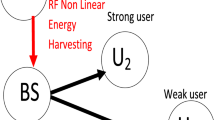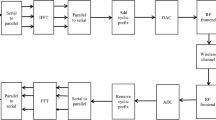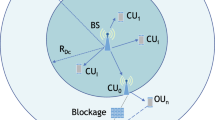Abstract
Resource allocation assigns subcarriers and power at the Base Station (BS) to different users, and is an important aspect in multiuser OFDMA downlink (DL) transmission. Various resource allocation approaches differ in the objectives and constraints in defining the problem and in the algorithms developed to solve the respective problems. Complexity of resource allocation mainly depends on the algorithm developed. This paper intends to fill gaps in literature by introducing graph based lower complex methodology to solve a per-symbol rate maximization problem for three different scenarios in which perfect Channel State Information (CSI) is available. Firstly, a Single Input Single Output (SISO) OFDMA system with Sub-band Carrier Assignment Scheme (SCAS) which supports only a single modulation scheme per user is considered. A SISO-OFDMA system with Generalized Carrier Assignment Scheme (GCAS) which supports multiple modulation schemes within a users’ sub-band is considered next, and finally a Multiple Input Multiple Output (MIMO) OFDMA system is considered. A new parameter is introduced to evaluate fairness of resource allocation, and extensive performance evaluation of developed algorithms based on average SNR values and fairness is carried out. MATLAB simulations show that algorithms perform well and allocate resources fairly even when the channel is extremely frequency selective.










Similar content being viewed by others
References
Shams, F., Bacci, G., & Luise, M. (2014). A survey on resource allocation techniques in OFDM(A) networks. Computer Networks, 652, 129–150.
Yuqing, C., Xiaoyan, L., Xixia, S., & Su, P. (2018). Resource allocation in multi-user MIMO-OFDM systems with double-objective optimization. KSII Transactions on Internet and Information Systems, 12(5), 2063–2081.
Janakiraman, N., Kumar, P. N., Rajeswari, R., et al. (2016). Dynamic resource allocation scheme for MIMO-OFDMA multicast system. Proceedings of the National Academy of Sciences, India, Section A: Physical Sciences, 86, 187–199.
Wu, W. C. (2019). Toward the energy efficiency of resource allocation algorithms for OFDMA downlink MIMO systems. Journal of Electronic Science and Technology, 17(4), 1–12.
Wu, W.-C., & Hsu, C.-Y. (2017). Subcarriers and its allocation algorithms for downlink OFDMA-based MIMO systems. Journal of the Franklin Institute, 354(11), 4615–4636.
Nidhal, O., et al. (2016). Utility-based resource allocation for interference limited OFDMA cooperative relay networks. Physical Communication, 20, 74–84.
Saini, R., et al. (2019). Subcarrier pairing as channel gain tailoring: Joint resource allocation for relay-assisted secure OFDMA with untrusted users. Physical Communication, 32, 217–230.
Femenias, G., Riera-Palou, F., & Thompson, J. S. (2016). Robust scheduling and resource allocation in the downlink of spatially correlated MIMO-OFDMA wireless systems with imperfect CSIT. IEEE Transactions on Vehicular Technology, 65(2), 614–629.
Femenias, G., & Riera-Palou, F. (2016). Scheduling and resource allocation in downlink multiuser MIMO-OFDMA systems. IEEE Transactions on Communications, 64(5), 2019–2034.
Zhang, C., & Fan, P. (2016). Providing services for the high-speed train and local users in the same OFDMA system: Resource allocation in the downlink. IEEE Transactions on Wireless Communications, 15(2), 1018–1030.
Abdelnasser, A., Hossain, E., & Kim, D. I. (2015). Tier-aware resource allocation in OFDMA macrocell-small cell networks. IEEE Transactions on Communications, 63(3), 695–710.
Liu, Y. (2014). Complexity analysis of joint subcarrier and power allocation for the cellular downlink OFDMA system. IEEE Wireless Communications Letters, 3(6), 661–664.
Hajipour, J., Mohamed, A., & Leung, V. C. M. (2016). Channel-, queue-, and delay-aware resource allocation in buffer-aided relay-enhanced OFDMA networks. IEEE Transactions on Vehicular Technology, 65(4), 2397–2412.
Kim, H., Lee, H., Ahn, M., Kong, H., & Lee, I. (2016). Joint subcarrier and power allocation methods in full duplex wireless powered communication networks for OFDM systems. IEEE Transactions on Wireless Communications, 15(7), 4745–4753.
Araniti, G., Condoluci, M., Iera, A., Molinaro, A., Cosmas, J., & Behjati, M. (2014). A low-complexity resource allocation algorithm for multicast service delivery in OFDMA networks. IEEE Transactions on Broadcasting, 60(2), 358–369.
Riera-Palou, F., & Femenias, G. (2018). Cluster-based cooperative MIMO-OFDMA cellular networks: Scheduling and resource allocation. IEEE Transactions on Vehicular Technology, 67(2), 1202–1216.
De La Fuente, A., Femenias, G., Riera-Palou, F., & Armada, A. G. (2018). Subband CQI feedback-based multicast resource allocation in MIMO-OFDMA networks. IEEE Transactions on Broadcasting, 64(4), 846–864.
Author information
Authors and Affiliations
Corresponding author
Additional information
Publisher's Note
Springer Nature remains neutral with regard to jurisdictional claims in published maps and institutional affiliations.
Rights and permissions
About this article
Cite this article
Anoop, C.V., Bhaskar, V. & Nithya, V. Lower Complex Resource Allocation Methodology based on Graph Theory and Index Matrix Rearrangement for OFDMA/MIMO-OFDMA Systems. Wireless Pers Commun 118, 2253–2277 (2021). https://doi.org/10.1007/s11277-021-08124-9
Accepted:
Published:
Issue Date:
DOI: https://doi.org/10.1007/s11277-021-08124-9




